
Interested in bringing back Bell Labs?
Some thoughts 🧵 on why it's not possible, and what we should do instead.... /1
Some thoughts 🧵 on why it's not possible, and what we should do instead.... /1
https://twitter.com/rrana03_/status/1353042869930569729
At peak, Bell Labs was about $2B/yr in today's USD. Split 30% fundamental research, 10% translation, 60% systems engineering. (straight from the source) /2 

For perspective, we're talking about a corporate R&D lab with a fundamental research arm twice the size but same caliber as Cal Tech alongside a systems engineering team roughly the same size/caliber of Space X (guessing), with a translation team >10x the size of Otherlab. /3
So please just quit with "X is the modern day Bell Labs" /4
Next: bear in mind that after WWII, academic research was small & ed focused (mainly philanthropy funded). So Bell Labs could control a signif portion of the fundamental research pipeline. That's no longer possible with U.S. gov alone now funding ~$50+B/yr to univs and FFRDCs. /5 

For that reason alone, it's not possible to recreate Bell Labs today. /6
That said, what we can (and should) recreate is the tight connection that existed in those days b/w fundamental research & application. At Bell Labs, science & application lived under one roof, which is all too rare today...for reasons I dive into here: /7 technologyreview.com/2020/06/17/100…
So how to bring back the mojo of Bell Labs today? Follow the trends:
- big corps no longer science powerhouses
- fundamental research pipeline now huge & distributed
- talent no longer needs big institutions for knowledge, networks, tools
Hint: it's def not a behemoth lab /8
- big corps no longer science powerhouses
- fundamental research pipeline now huge & distributed
- talent no longer needs big institutions for knowledge, networks, tools
Hint: it's def not a behemoth lab /8
Startups. Startups are the most vibrant environment today for Bell Labs style intermixing of fundamental research and applied systems. And they are changing the world in Bell-Labs magnitude ways. Just look at @BioNTech_Group and @moderna_tx /9
https://twitter.com/IlanGur/status/1343250717537042432
There's just one problem: we only get startups around people/ideas that VCs are willing to bet on at any given moment. /10
Isn't it weird that we're ok depending on VCs making crazy early out-of-the-money option bets in order for top talent to translate scientific research into products in an aggressive way? /11
(Incidentally: this is the thesis behind @activatefellows)
activate.org
(Incidentally: this is the thesis behind @activatefellows)
activate.org
The first few years of a deep science startup are basically focused, aggressive applied R&D. It's cool VCs can sometimes cover that, but it's nowhere near enough. What about people not plugged into VC, or ideas that need more time/resources or don't fit the latest hype cycle? /12
This is where we need government. Bell Labs is remembered as a great INDUSTRIAL research lab, but only existed thx to gov funding (via a gov-sanctioned monopoly). Gov $ is the *only* way to support applied R&D at the scope & scale needed to serve society on #climate & beyond. /13
How can the U.S. invest toward Bell Labs outcomes? Start by modernizing science & industrial policy, recognizing that the U.S. advantage in [science x entrepreneurship] is enormous & still largely untapped in its potential to create opportunity, prosperity, & a better future. /14
Bring back Bell Labs? Nah... But maybe we can do even better.
Check out some great ideas from @Day1Project contributors @ActuateOrg @AdamMarblestone @FerGomezBaquero @C9Martin @ktrae @SGRodriques and more...
dayoneproject.org/conversations
Check out some great ideas from @Day1Project contributors @ActuateOrg @AdamMarblestone @FerGomezBaquero @C9Martin @ktrae @SGRodriques and more...
dayoneproject.org/conversations
• • •
Missing some Tweet in this thread? You can try to
force a refresh


